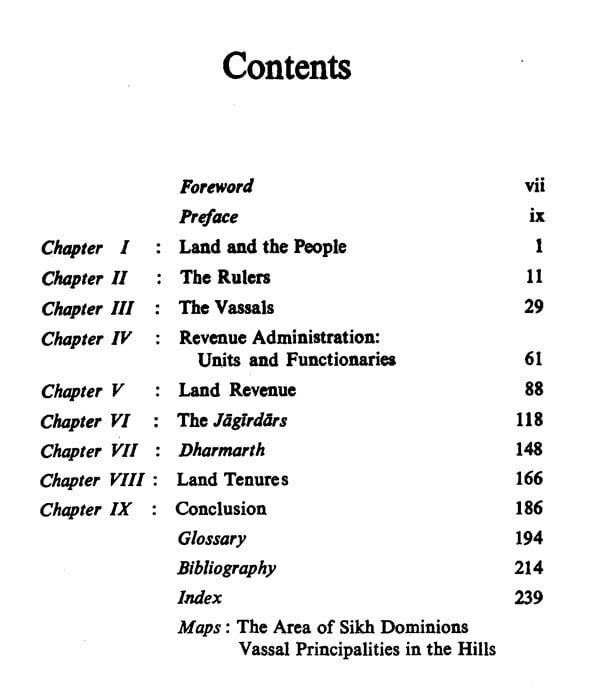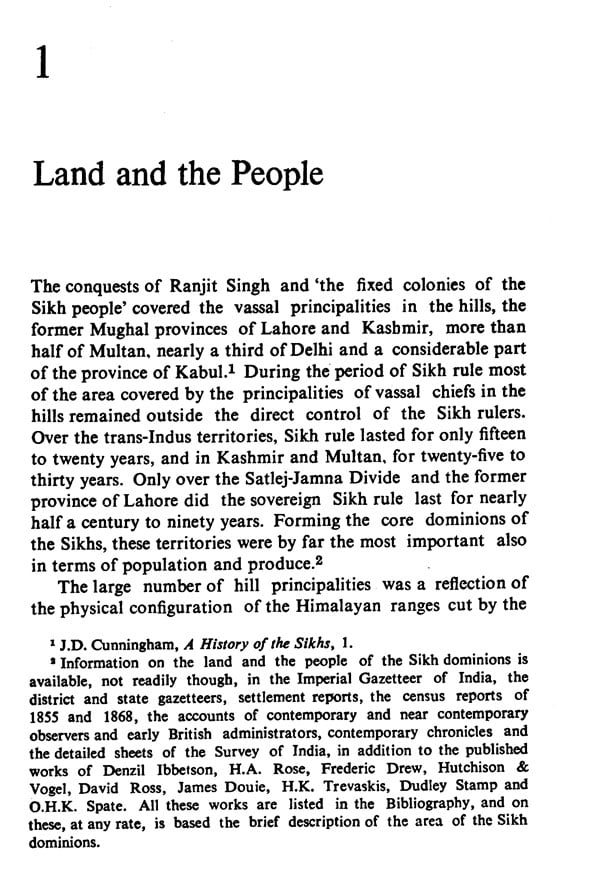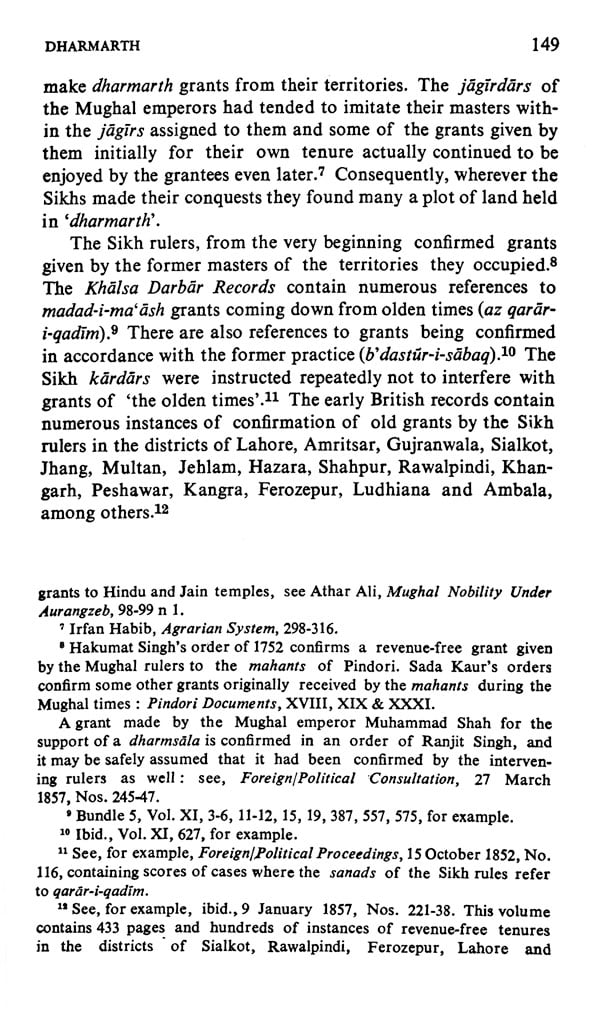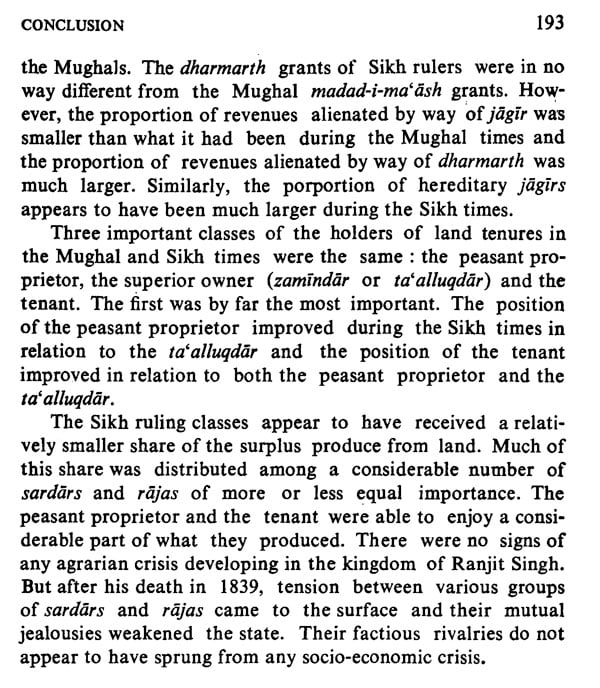
Agrarian System of The Sikhs- Late Eighteenth and Early Nineteenth Century (Manohar Classics)
Book Specification
| Item Code: | NAZ768 |
| Author: | Indu Banga |
| Publisher: | Manohar Publishers and Distributors |
| Language: | English |
| Edition: | 2021 |
| ISBN: | 9789388540193 |
| Pages: | 282 (2 B/W Maps) |
| Cover: | HARDCOVER |
| Other Details | 8.80 X 5.80 inch |
| Weight | 440 gm |
Book Description
This seminal study of late medieval Punjab under Sikh rule proceeds from certain assumptions. In addition to produce from land and revenues, Agrarian System covers the social strata connected with agricultural production, collection of revenues and control of land. The institutionalized landed relations having a life of their own cut across conventional periodization. This interplay between land and people is comprehended more meaningfully in a regional context viewed in a larger perspective. Ideology too has a bearing on acquisition and exercise of power. Thus, emergence of over three scores of new centres of power created by the Sikhs in the late eighteenth century, and their unification under Maharaja Ranjit Singh in the early-nineteenth, reflects broad continuities in the area that remained under Sikh rule for the longest period.
After a brief exposition of the political process and its ideological underpinnings, the book focuses on the changing position of the vassal chiefs, the jagirdars, the pattidars (petty Sikh conquerors), the dharmarth or madad-i-ma'ash grantees, and the proprietors and tenants in the context of land revenue, its administration and landed rights. Significantly, women figure in some of these situations. This study concludes with reference to continuities and changes since the Mughal times.
The author has made an ample use of the Khalsa Darbar Records at the Punjab State Archives now at Chandigarh, early British records at the National Archives of India, Delhi, besides official orders, news-letters, contemporary chronicles, travel accounts, revenue manuals, and gazetteers.
Indu Banga, Professor Emerita, Panjab University, Chandigarh, and formerly Professor of History, Guru Nanak Dev University, Amritsar, has authored/edited over 15 books on agrarian, urban, institutional, social and cultural history of medieval and modern India and the undivided Punjab, including Civil and Military Affairs of Maharaja Ranjit Singh (conjoint 1987), Five Punjabi Centuries (2000), The City in Indian History (2005), and Early-Nineteenth Century Panjab (conjoint 2016).
This book is the revised version of my Ph.D. thesis submitted at Guru Nanak Dev University, Amritsar, in 1974. It covers the period of Sikh rule in the Panjab during the late 18th and early 19th centuries. Besides a brief exposition of the political and institutional developments of the period, which had a bearing on the agrarian system, the foci of this study are the vassal chiefs, the jagirdars, the dharmarth grantees, the peasants, land revenue, revenue administration and land tenures. On the whole, the book breaks a fresh ground in regional history, more specifically in the history of the Panjab.
Nevertheless, this study is better viewed in relation to the socio-economic history of medieval India. Despite the recent interest in trade and industry, and in urbanization, the major thrust in the socio-economic history of medieval India has been in the area of agrarian history as, for instance, in the works of W.H. Moreland and Irfan Habib. The questions which these historians have posed and answered relate basically to the produce from land and its division between the cultivator and the state. It is in this context that the rates and methods of assessment and the modes of collection acquire meaning and significance. The machinery devised by the state for these purposes comes in for serious attention. However, the state did not collect all its share directly, and hence the importance attached to the role of the intermediaries. Also, the revenues due from land were assigned to a large number of its employees in jagir, and hence the relevance of the jagirdari system for socio-economic history. Similarly, the state alienated its share by way of reward or charity. The most important of such grantees were individuals and institutions connected with religion, and hence the importance of madad-i-ma'ash or dharmarth grants. Above all, the question of the condition of the peasant is closely related to the share he gets from the produce, the nature and character of the administration, and the attitude of the intermediaries as well as the administrators. Studied in this manner, agrarian matters cover not merely the produce from land and land revenue but also embrace the social strata, like the ruling classes, the peasantry and the intermediary categories.
The Sikhs during the phase of their political struggle in the 18th century and of the state power during the first half of the 19th century had developed political and social institutions which were appreciably different from those developed in any other part of the country. Dr. Banga has discussed with great ability the nature and development of many of these institutions, especially the Ralchi, the Gurmata, the Dal Khalsa and the Misl.
The Sikh movement started with a special appeal to the trading classes. Nevertheless, it struck deep roots in the peasantry, simultaneously developing its own feudal relations. These feudal relationships affected land rights and the relations of the state with various agrarian classes through the function-ing of the land revenue administration. They are of special interest to the students of social and economic history. There was no sharp break with the agrarian relations and the mode of agricultural production as it existed in the Mughal times and yet, as Dr. Banga has shown, the land system under the Sikhs developed its own characteristic features. By the use of detailed original source material, much of which had not been utilized before, Dr. Banga's work has become invaluable for a meaningful study of agrarian relations in the Punjab from the middle of the 18th to the middle of the 19th century.
Book’s Content and Sample Pages
















